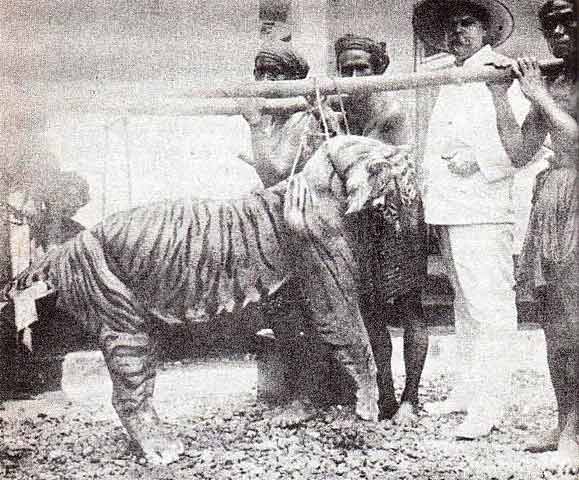The Bali tiger, a symbol of Indonesia’s rich biodiversity, once roamed freely on the picturesque island of Bali. Known scientifically as Panthera tigris balica, this tiger subspecies was unique in size and appearance, setting it apart from its larger relatives.
Its existence on the island painted a picture of nature’s grandeur, intertwined with the cultural and spiritual life of the Balinese people.
Quick Overview
| Attribute | Details |
|---|---|
| Habitat | Dense forests and protected areas of Bali |
| Weight | Male: 90-100 kg (198-220 lbs) Female: 65-80 kg (143-176 lbs) |
| Length | Male: 2.2-2.3 meters (7.2-7.5 feet) Female: 1.9-2.1 meters (6.2-6.9 feet) |
| Diet | Wild pigs, smaller mammals, fish |
| Conservation Status | Extinct (last confirmed sighting in the 1930s) |
| Population | – |
| Primary Threats | Hunting, habitat loss, and human-wildlife conflict |
Taxonomy
The journey of classifying the Bali tiger has been an evolving one. In 1912, German zoologist Ernst Schwarz described the skin and a skull of an adult female tiger from Bali, which was part of the Senckenberg Museum collection.
He named it Felis tigris balica, highlighting its distinctiveness due to its brighter fur color and a smaller skull with narrower zygomatic arches. However, by 1969, the distinctiveness of the Bali tiger was debated.
Morphological analysis showed that its size variation was similar to the Javan tiger, and there was no significant difference in the hue and striping pattern of the fur.
A turning point came with a mitochondrial DNA analysis of 23 museum specimens of Bali and Javan tigers. The results revealed a close genetic resemblance among the tigers of the Sunda Islands, forming a distinct group separate from the tigers of mainland Asia.
In light of these findings and further research, the Cat Classification Task Force of the Cat Specialist Group, in 2017, revised the felid taxonomy.
They recognized the extinct Bali and Javan tiger populations and the Sumatran tiger populations under the classification P. t. sondaica.
| Kingdom | Animalia |
|---|---|
| Phylum | Chordata |
| Subphylum | Vertebrata |
| Class | Mammalia |
| Order | Carnivora |
| Suborder | Feliformia |
| Family | Felidae |
| Genus | Panthera |
| Species | Panthera tigris |
| Sub Species | Panthera tigris sondaica |
Characteristics

With its unique appearance and size, the Bali tiger stood out among the tiger subspecies. It was the smallest of the tiger subspecies.
Males typically weighed between 90-100 kg (198-220 lbs) and measured around 2.2-2.3 meters (7.2-7.5 feet) in length from head to tail. Being slightly smaller, females weighed between 65-80 kg (143-176 lbs) and had a length of approximately 1.9-2.1 meters (6.2-6.9 feet).
Their fur was a vibrant, deep orange, adorned with closely set, dark stripes. This distinct striping pattern gave them ideal camouflage amidst the dense Balinese forests. Their smaller size is believed to be an outcome of island dwarfism, an evolutionary adaptation to the island’s restricted resources and space.
The Bali tiger’s physical attributes and unique habitat made it an exceptional member of the tiger family.
Distribution and Habitat

The Bali tiger was a true islander, found only on the Indonesian island of Bali. They predominantly inhabited the western part of the island, where dense forests provided ample cover.
These forests, ranging from the lowlands to the highlands, offered a mosaic of habitats. With its diverse flora and fauna, the Barat National Park was one of the last refuges for this tiger subspecies before their tragic extinction.
Behavior and Ecology

Bali tigers played a pivotal role in the island’s ecosystem as apex predators. Their diet consisted of wild boar, various deer species, and smaller mammals.
Their hunting techniques were a testament to their adaptability and intelligence, often stalking their prey silently before launching a swift attack.
Solitary by nature, these tigers had well-defined territories marked using scent markings. Their vocalizations, ranging from roars to chuffs, facilitated communication, especially during mating seasons.
Conservation and Extinction

The Bali tiger’s decline was a culmination of several factors. As the human population on the island expanded, their habitats were encroached upon. Hunting, both for sport by Dutch colonists and for ceremonial purposes by locals, further dwindled their numbers.
By the 1940s, sightings of the Bali tiger had become exceedingly rare. The last known Bali tiger was tragically shot and killed in 1937. Despite sporadic reports of sightings in the subsequent decade, by the 1950s, the world had to come to terms with the extinction of this magnificent creature.
In Culture
The Bali tiger was deeply ingrained in the cultural fabric of the island. It was revered and often featured in local myths, legends, and art.
It was also considered a spiritual entity, with some local beliefs attributing protective qualities to the tiger.
Conclusion
The tale of the Bali tiger is a poignant reminder of the fragile balance of nature. Their extinction underscores the importance of proactive conservation efforts and the need for coexistence.
As we reflect on their legacy, it becomes imperative to champion the cause of the remaining tiger subspecies and other endangered wildlife, ensuring that their stories don’t echo the tragic fate of the Bali tiger.
FAQs
The Bali Tiger was a unique subspecies of tiger that was native to the Indonesian island of Bali.
No, the Bali Tiger is believed to have gone extinct in the 1940s.
The Bali Tiger was smaller in size compared to other tigers and had a distinct fur pattern and coloration.
The primary reasons for its extinction were habitat loss due to agricultural expansion and hunting.
Males weighed between 90-100 kg (198-220 lbs) and females around 65-80 kg (143-176 lbs). They had a body length of about 2-2.2 meters (6.5-7.2 feet) for males and 1.8-2 meters (5.9-6.5 feet) for females.



